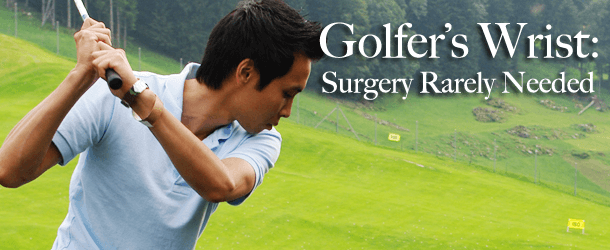
Q: I golf three to four times each week, but lately the pain in my wrists makes golfing extremely uncomfortable. A friend of mine had similar symptoms and ended up having surgery to treat tendinitis. Is there a way to get some relief that won’t require surgery?

A: Wrist injuries are common in people who play golf regularly. These injuries often occur due to overuse, poor mechanics or trauma. The right treatment depends on the underlying cause. For most people with the type of wrist pain you describe, surgery is rarely needed.
Many golfing-related wrist injuries are a result of overuse, particularly in recreational golfers who take a break during the winter, and then play a lot during warmer months. For example, some golfers may go to the driving range for the first time in the spring and hit 200 balls in one session, or they may start playing four rounds of golf a week after taking several months off. Both situations could lead to wrist injuries.
Poor mechanics may also be to blame. For example, if a golfer is swinging the club inappropriately or “casting” the club, it could lead to pain at the back of the wrist due to injury to a tendon called the extensor carpi ulnaris. In time, that can result in chronic wrist pain.
Wrist injuries also can come from some type of trauma. A golfer may be playing in the rough, for example, swing hard and catch the club in the long grass. That can twist the wrists and, depending on the power of the swing, cause serious wrist tendon damage or even break a bone. Similar injuries may happen if a golfer takes a large divot out of the turf or hits a rock or other solid object with a club.
When wrist pain and swelling first appear, the best steps are to rest it and put ice on it to bring down the swelling. Using heat on the injured area can relieve soreness and stiffness. A compression wrap or a wrist brace also may be helpful. If symptoms continue for more than a week and the pain gets worse, medical attention is in order.
Your doctor will likely ask about your symptoms, when and how they started, and examine your wrist. This can help shed light on how the injury occurred and determine if tests such as X-rays, computerized tomography (CT) or magnetic resonance imaging (MRI) scans are needed to diagnose the problem.
If the condition is tendinitis, it may get better with just rest and physical therapy. You might need to wear a wrist brace, as well. If that’s not enough, an injection of a corticosteroid can help reduce inflammation in the injured area to allow for healing. Rarely, if nothing else has helped, surgery may be an option for chronic tendinitis.
For a broken wrist bone, a cast may be needed to allow the injury to heal, and physical therapy eventually may be necessary. In most cases of a broken wrist bone, no additional treatment beyond those two measures is required. Depending on the type of broken bone, however, in rare circumstances surgery may be needed.
To help prevent future golfing-related wrist injuries, take time to stretch your arms, elbows and wrists before you play. Also, warm up with some easy practice swings before you begin a round of golf or start hitting at the driving range. Work on improving your swing, too. Take a lesson occasionally to make sure your form is still good. Finally, invest in quality equipment. Clubs with graphite shafts and irons that are cavity-backed reduce the vibration of impact and can help prevent injuries. Something as simple as using fatter grips to keep you from squeezing the club too tightly and aggravating tendinitis also may be of benefit.
– Sanjeev Kakar, M.D.
Orthopedic Surgery, Mayo Clinic, Rochester, Minn.
Medical Edge from Mayo Clinic is an educational resource and doesn’t replace regular medical care. To submit a question, write to: medicaledge@mayo.edu, or Medical Edge from Mayo Clinic, c/o TMS, 2010 Westridge Drive, Irving, TX 75038. For health information, visit www.mayoclinic.com.
(c) 2012 MAYO FOUNDATION FOR MEDICAL EDUCATION AND RESEARCH. ALL RIGHTS RESERVED DISTRIBUTED BY TRIBUNE MEDIA SERVICES, INC.

